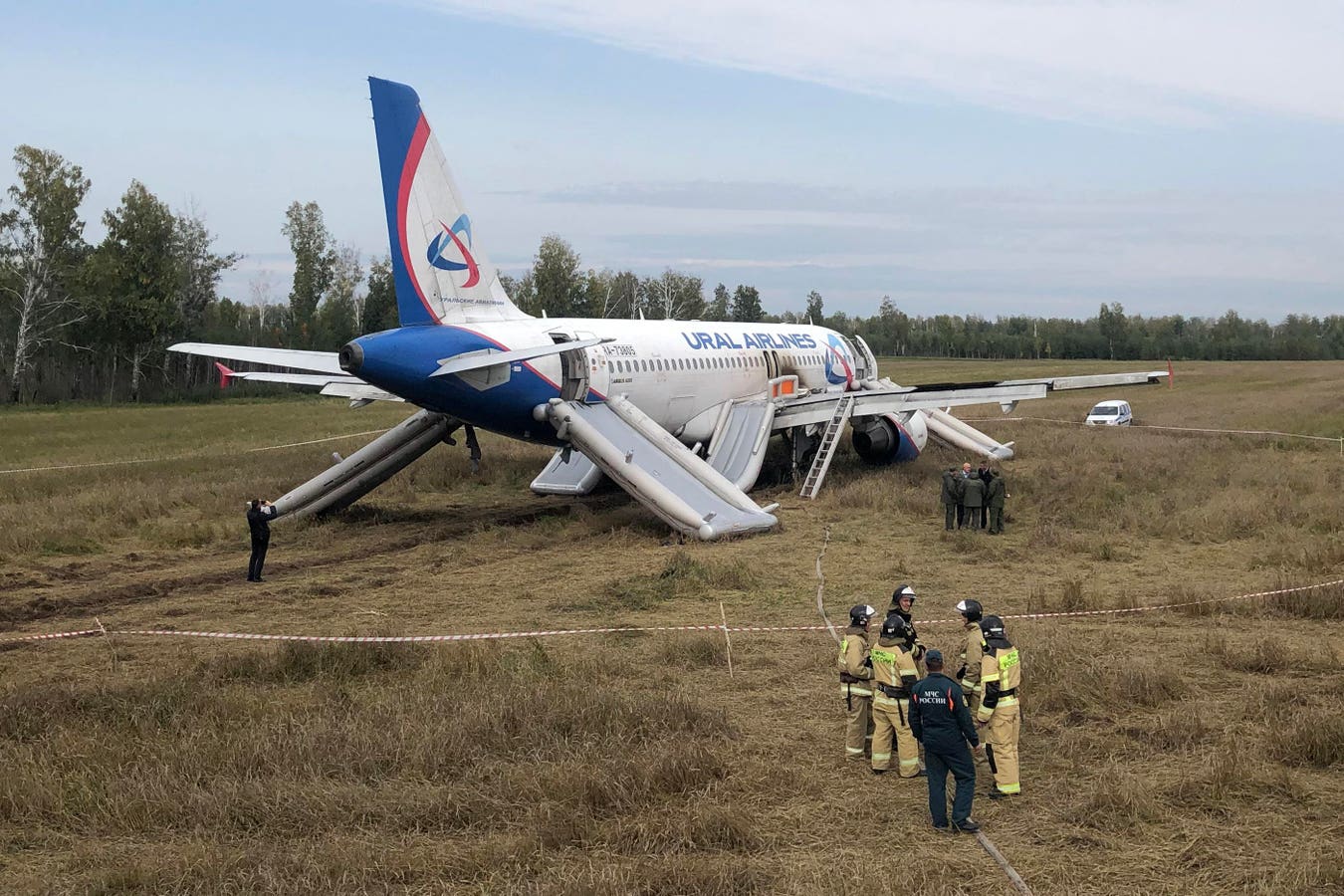A Telegram post by Russian carrier, Ural Airlines, claims it is considering “several options” for flying its Airbus A320 out of the wheat field it made an emergency landing on.
The A320 made an emergency landing in the field on the approach to the airport at Omsk, a Russian city in southwestern Siberia, last month after an apparent hydraulics system failure. The BBC reported that there were no injuries among the 170 passengers onboard. The news service relayed a statement from Ural Airlines which said the pilot “selected” the landing site after the hydraulic issue.
The incident gave rise to speculation that the failure is related to the airline’s inability to properly service its fleet with appropriate manufacturer-provided spare parts in the wake of Western sanctions on Russia tied to its invasion of Ukraine. In October of 2022 Reuters reported that the U.S. Commerce Department issued an order denying export privileges to Ural Airlines, citing what it said were ongoing export violations.
Commerce specifically warned that any refueling, maintenance, repair, spare parts or services provided to Ural by commercial support services companies violate U.S. export controls and subject companies to U.S. enforcement actions.
I wrote about Russian airlines’ ability to keep their fleets of Western aircraft operable in the face of sanctions last year, a feat they have largely managed to pull off. Whether this emergency is evidence of pressure on their operational safety or not is hard to say.
But the fact that Ural wants to fly the aircraft from a field rather than dismantle it for shipment to an airport and eventual rebuild by its own technicians may indeed indicate the pressure that Russian carriers are under.
The airplane in question was formerly owned by SMBC Aviation Capital before Russia seized it and other Western airliners following the outbreak of the Ukraine conflict. In the past, such an incident would have seen technical teams from Airbus travel to the site to oversee dismantling and removing the A320.
It would likely have been sent to a major Russian overhaul center for a rebuild with oversight from the manufacturer. Another A320 or A320-family variant would have been temporarily provided as a substitute to Ural via a lessor. At present, that cannot happen.
According to the carrier’s Telegram post last week, Ural is looking to fly the airliner out of the field. The post claims that the A320’s engines have been bore-scoped (internally inspected via a miniature optical apparatus) to check for damage and given a thumbs-up. The engine intakes and first turbine stage have apparently been “cleaned of soil and straw” and inspected a second time. Some sort of airframe structural inspection was made as well.
At the time of the post (October 3) which Ural curiously titled “News from the fields”, the airline was awaiting lifts to raise the aircraft off of its landing gear to cycle them (raise the gear up and down) to check for functionality. Components like the gear struts, wheels, brakes and tires will presumably be checked as well. Oddly, the post makes no mention of addressing the hydraulic issue that forced the airplane down.
“According to the preliminary technical assessment of specialists, the aircraft is in good condition,” Ural Airlines said in a statement relayed by Reuters, adding that the airliner will likely be able to carry out flights in the future.
While it may sound far-fetched, Ural would not entirely set a precedent in flying its jet airliner out of a field. In the 1980s, Transafrik International, a cargo airline operating in Angola, routinely landed and took off from a rough dirt field strip using its Boeing 727 freighters.
As can be seen in the video below (at 7:17) the converted airliners took off from dusty, uneven ground near a diamond mining site adjacent to the Kwango River. The Siberian wheat field where Ural’s A320 made a remarkable emergency landing – remarkable because the flight crew lowered the gear to land instead of belly-landing as would be procedure in most such off-airport situations – may actually be less challenging.
By November, the average high temperatures in the area will be about 27 degrees Fahrenheit (-3 Celsius) and in December will only reach 15 degrees Fahrenheit (-9 Celsius). The ground will thus be frozen and able to support the weight of the aircraft. The local authorities will likely mow the field in preparation, rendering it similar to the dirt used by Transafrik.
Carving out a clear strip will be more important in this instance since unlike the elevated trio of engines in the 727’s tail, the A320’s twin-engine underwing design (a ubiquitous configuration in modern airliners) places the engines and their intakes close to the ground.
Judging from a drone video of the site posted by AIRLIVE
IVE
But as Ural’s Telegram post notes, it will likely remove all the seats from the airliner, taking out significant weight. If they remove other equipment and make sure the fuel load is just enough to get to nearby Omsk Central Airport, it could get airborne in as little as 4,000 feet.
A crew of just two (pilot, co-pilot) could fly the aircraft away provided it has been checked thoroughly and is indeed safe for flight. Whether Ural Airlines will look to change its tail number when and if it re-enters airline service is anybody’s guess. The widely distributed photos identifying it may make some future passengers wary of getting aboard the “Wheat Field Airbus”.
Whimsy aside, Ural’s attempt to return the airliner to service with a successful flight out of a farm field and some level of subsequent refurbishment indicate the pinch Russian airlines may be in and the level of air safety their passengers may face as a result.
There should at least be impressive video of the A320 launching some time in the near future. Prepare for takeoff.
Read the full article here





